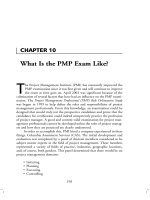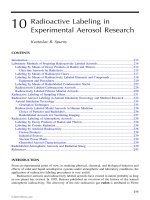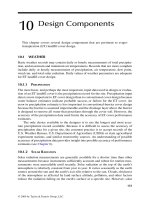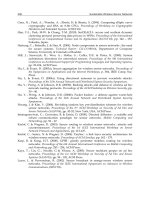ADMINISTERING CISCO QoS IP NETWORKS - CHAPTER 10 docx
Bạn đang xem bản rút gọn của tài liệu. Xem và tải ngay bản đầy đủ của tài liệu tại đây (478.65 KB, 46 trang )
Overview: Border
Gateway Protocol
(BGP)
Solutions in this chapter:
■
The History of BGP
■
Maximizing the Functionality of BGP
■
External BGP and the Internet
■
The BGP Path Selection Process
■
Redistributing BGP into Your IGP
■
Defining Internal BGP, Route Reflectors,
and Confederations
■
Advanced BGP Network Design
Chapter 10
375
110_QoS_10 2/13/01 11:51 AM Page 375
376 Chapter 10 • Overview: Border Gateway Protocol (BGP)
Introduction
As at press time, the Internet holds well over 90,000 routes, which is far more
than Interior Gateway Protocols (IGPs) such as EIGRP or OSPF were designed
to handle. Additionally, whereas private internetworks generally have only a few
possible paths, with the Internet, there could literally be thousands of ways to
arrive at the same destination. EIGRP or OSPF would have major problems
under these circumstances.
Clearly, another protocol is needed to deal with the complex routing issues
on the public Internet.The answer to this problem is BGP, or, more precisely,
BGP 4. Unlike OSPF or EIGRP, which were designed to be intra-AS
(autonomous system), BGP was specifically designed to route traffic between
autonomous systems, and is therefore called an Inter-AS routing protocol.
This chapter gives some background on the development of this protocol,
explains the difference between EBGP and IBGP, explores some of the most
popular design concepts, and discusses more complex issues such as route reflec-
tors and confederations.
The History of BGP
Border Gateway Protocol 4 (BGP 4) was preceded by BGP 1, BGP 2, and BGP 3
as standards for use in exchanging TCP/IP routing information between
domains. Furthermore, all BGP versions were preceded by the Exterior Gateway
Protocol (EGP) as both a standard and a protocol for interdomain routing.The
Internet and most of the backbone providers were using EGP exclusively until
the mid 1990’s.There was limited use of BGP 3 on any production network, pri-
marily because of the stability of EGP and the lack of significant differences in
features available in BGP 3.
However, BGP 4 was developed to fix several major problems with EGP, and
it led to the widespread use of BGP that exists today. Specifically, BGP 4 pro-
vided for the use of classless interdomain routing (CIDR), it provided for a more
open topology structure between BGP speakers, and it could coexist with EGP
on a router.These features provided a means of minimizing the routing tables and
easily moving to this new standard.
Exterior Gateway Protocol (EGP)
The Exterior Gateway Protocol dates back to the early 1980’s. Its implementation
assumed an engineered tree topology throughout the Internet. Since there was no
www.syngress.com
110_QoS_10 2/13/01 11:51 AM Page 376
www.syngress.com
overall network architect authority for the Internet and connecting regional net-
works, this limitation was the root cause of many problems associated with full
mesh peering.The full mesh network configuration created backdoor routes
between regional networks that resulted in “suboptimal routing,”“routing loops,”
or “black holes” that prevented IP packets from traversing the Internet efficiently.
Suboptimal routing can best be described as routing that does not use the
best path between the source and destination systems.A “routing loop” is a situa-
tion that exists when two systems both see each other as an appropriate next hop
to forward packets for a given network.The forwarding decision is determined by
the routing table, derived from the routing protocol. In this situation, both sys-
tems will forward packets to each other until the time-to-live (TTL) for the
packets is exhausted. A “black hole” occurs when a collection of routers believes
that the best forwarding path to a destination network is via a router that does
not have a route to the destination network. Supposing we refer to this router as
Router A, when other routers send packets destined for the unknown network to
Router A, and it does not know how to reach this destination, Router A simply
discards the packets. Since it appears that the packets disappeared for no apparent
reason, they are spoken of as having disappeared into a “black hole.”This is how
the term “black hole” came to be used. EGP could not prevent the propagation
of false routing information between regional networks and the backbone
Internet that created these situations.
RFC 1092,“EGP and Policy Based Routing in the New NSFNET
Backbone,” addressed these problems in relation to the NSFNET.This RFC
acknowledged that because the processes proposed were interim measures and
did not scale for a global Internet, they should be used only until a better routing
algorithm could be developed and put into use.
The Original Implementation
RFC 1267 established the standards for the original implementation of BGP.This
implementation is also referred to as BGP 3. It built upon lessons learned with
EGP and began the transition process. However, there is no evidence of wide-
scale use of this protocol in the Internet, and it was simply relegated to labs and
test networks for test purposes. Since this implementation of BGP did not solve
the most pressing needs of backbone providers, namely, the classful routing
dilemma, there was no incentive to go through the trouble of conversion.
BGP was introduced as an inter-autonomous system (AS) routing protocol.
An AS is defined as a collection of routers under a common administration.
Furthermore, within the AS you can have multiple Interior Gateway Protocols
Overview: Border Gateway Protocol (BGP) • Chapter 10 377
110_QoS_10 2/13/01 11:51 AM Page 377
378 Chapter 10 • Overview: Border Gateway Protocol (BGP)
(IGPs) that are used to exchange network routing information. A BGP speaker’s
primary function is to exchange network reachability information with other
BGP systems. Since the BGP speaker sees the Internet as a collection of
autonomous systems (AS), the network reachability information includes the full
AS path that traffic must travel to reach these networks.This information allows
the BGP system to construct a graph of AS connectivity.This graph is used to
prune routing loops, and it permits policy decisions by the system.Thus, BGP is
best described as a hop-by-hop protocol in which each system advertises only the
network reachability information that it uses.
The implementation of BGP 3 introduced the foundation elements that are
still in use today. First of all, BGP systems establish a connection upon initializa-
tion over TCP using port 179. Next, the systems exchange the complete routing
table and send incremental updates only as necessary. Since there is no provision
to periodically refresh the complete BGP database, all systems keep track of a ver-
sion of one another’s table.
Once the BGP speakers enter the established state, the BGP scanner process
on each system ensures consistency among the BGP database, the IGP database,
and the IP routing table. If you issue the exec command show process cpu, you
will see this process in the list identified as BGP Scanner. It is important to note
that this process is different from the BGP Router process, which is used to
establish and maintain the BGP session.
Finally, the session will remain up unless the connection experiences an
error condition.When this situation occurs, the initialization process begins and
will continue until the BGP session is reestablished.This procedure is fairly
straightforward and depends on the reliability provided with a TCP connection.
The fundamental elements of BGP 3 provided a stable basis on which to make
the improvements that were eventually released as BGP 4.
The Current RFC
The current RFC standard actually consists of two documents: RFC 1771,“A
Border Gateway Protocol 4 (BGP 4),” and the companion document, RFC 1772,
“Application of the Border Gateway Protocol in the Internet.” Both documents
define the inter-autonomoussystem routing protocol in use today. Fundamentally,
BGP 4 is simply a new and improved version of its predecessor.The foundation
elements of BGP 4, such as BGP connection, messages, peer establishment, and
error correction mechanisms, are essentially the same as in BGP 3.
www.syngress.com
110_QoS_10 2/13/01 11:51 AM Page 378
Overview: Border Gateway Protocol (BGP) • Chapter 10 379
However, BGP-4 provides a new set of mechanisms to support both
Classless Interdomain Routing (CIDR) and Variable Length Subnet Mask
(VLSM).
BGP 4 also introduces mechanisms to aggregate routes and AS paths.These
additions make supernetting possible and serve as a solution to database growth
on the Internet, as well as a means to address the IP, version 4, address space
depletion problem.This concept is called classless interdomain routing (CIDR)
and is explained in the CIDR sidebar in this chapter.
This implementation of BGP 4 also provides support for multiple network
protocols, such as IPv4, IPv6, and IPX, which allows it to carry network infor-
mation for these protocols. In this form, BGP is known as Multiprotocol BGP
(MBGP). RFC 2283 outlines the specifications for all protocols supported, and
the mechanisms to exchange reachability information between BGP speakers. In
general, the individual network layer protocols are identified by an Address
Family (AF), defined in RFC 1700.Through the multiprotocol extensions, BGP
peers can, with a single peering session, exchange reachability information on
multiple AFs, such as IPv4, IPv6, and IPX, ,as well as subAFs, for instance, unicast
and multicast.
Finally, BGP4 provides an easy means to work with EGP that facilitates a
transition path to this new standard.This probably is what finally served to make
BGP 4 the preferred interdomain routing protocol compared to EGP and all pre-
vious versions of BGP.
www.syngress.com
The specifications of CIDR are listed in RFC 1519. These standards were
adopted to curb the routing table growth on the backbone Internet
routers in the early 1990’s. Between 1991 and 1995, the Internet
routing tables doubled every 10 months. If CIDR had not been stan-
dardized and implemented, we could have had hundreds of thousands
of Internet routes in the routing tables today.
CIDR, simply stated, provides a means to view a network and
mask combination that will summarize a group of consecutively num-
bered networks into a single advertisement. This summarized group of
networks is known as a supernet. Consider the Class C network
Classless Interdomain Routing
(CIDR) and the Current RFC
Continued
110_QoS_10 2/13/01 11:51 AM Page 379
380 Chapter 10 • Overview: Border Gateway Protocol (BGP)
Maximizing the Functionality of BGP
BGP works like any other routing protocol by maintaining routing tables,
exchanging routing updates with peer routers, and making routing decisions
based on BGP and neighbor parameters.
Each BGP speaker exchanges network reachability information that includes
the AS path list to permit the building of an AS graph for all network prefixes.
This graph, or tree, is used to prune routing loops, and it determines the best for-
warding path to place into the forwarding database or routing table. All routing
information is retained by the BGP speakers until an update message withdraws
the network prefix, changes the AS path, or modifies a metric.
The BGP Routing Process
The BGP routing process begins with the establishment of a connection. Once
this connection is created and both BGP speakers agree on the parameters to use
for the session, a complete BGP database is sent by each system.The systems keep
the session alive with periodic KEEPALIVE messages and will send a BGP
UPDATE message only if a network prefix is modified with a different AS path
or metric. In this case, the network prefix entry is updated in all BGP tables, as
www.syngress.com
192.168.3.0 and natural mask of 255.255.255.0. In this example, we
know the network identifier is 192.168.3.0. In CIDR terminology, this
network-mask pair is represented as 192.168.3.0/24. The /24 indicates
the masking length in bits for the network identifier. In this case, 24 bits
of network mask are used to identify the network bit boundary. If we
attempt to summarize a group of Class C networks into a supernet that
includes the network 192.168.3.0, we only need to reduce the number
of bits that indicates the network mask. Thus, a supernet of
192.168.0.0/16 indicates a CIDR block of contiguous networks with 16
bits identifying the network boundary. In this example, the address
range is 192.168.0.0 to 192.168.255.255. You can see just from this
example how CIDR has helped slow down the growth of the routing
table size for Internet routers.
Today, the use of CIDR and supernetting has spread to the enter-
prise network for the same reasons that it was used in the Internet.
However, you must remember that using CIDR and supernets requires a
routing protocol that can pass along network and mask combinations in
the routing advertisement. For example, BGP 4, OSPF, and EIGRP are
examples that can be used in this environment.
110_QoS_10 2/13/01 11:51 AM Page 380
Overview: Border Gateway Protocol (BGP) • Chapter 10 381
appropriate. If a network prefix disappears, then a BGP UPDATE message is sent
out that withdraws the network prefix or prefixes from all BGP tables. In such a
case, the prefixes are removed from the BGP tables until a BGP UPDATE mes-
sage is received that specifically adds the networks back.
The BGP system keeps track of the current database version for all BGP
speakers, and it can determine the reliability of the data in updates and
KEEPALIVE messages. Since all BGP speakers track one another’s database ver-
sions, they can use this to detect missed updates and determine the reliability of
information from their respective neighbors.This mechanism enables the various
BGP neighbors to simply send out incremental updates to the BGP database as
necessary, and avoids the need to periodically resend the complete BGP database.
This process that BGP systems cycle through is called the BGP Finite State
Machine. Figure 10.1 depicts the movement through this cycle and identifies the
decision points in the cycle.
BGP Finite State Machine Logic
The following information summarizes the various transitional states that a
BGP speaker goes through with the BGP Finite State Machine. Refer back to
Figure 10.1 for clarification.
■
1 Idle This is the first state in the BGP Finite State Machine cycle. At
this stage, the BGP speaker is waiting for a Start event. A Start event can
be caused by an Administrator establishing a new BGP router configura-
tion peer statement or resetting an existing BGP peer session. In this
state, the BGP speaker initiates the TCP session with the BGP peer.
■
2 Connect At this stage, the BGP speaker is waiting for the TCP con-
nection to establish.When this occurs, it moves to the OpenSent state. If
the TCP transport fails, the state becomes Active. If the ConnectRetry
timer expires, the state remains in the Connect phase.Any other events
initiated by the system or operator cause the state to return to Idle.
■
3 Active In this stage, the BGP system attempts to establish a TCP ses-
sion. Once the TCP session is established, the BGP session is in the
OpenSent state. If the TCP session fails to establish and the
ConnectRetry timer expires, the BGP session returns to the Connect
state. If the system or operator causes a Stop event, the session will revert
to the Idle state.
■
4 OpenSent In this state, BGP is waiting for a BGP OPEN message.
Once the OPEN message is received, it is checked for errors. If errors
www.syngress.com
110_QoS_10 2/13/01 11:51 AM Page 381
382 Chapter 10 • Overview: Border Gateway Protocol (BGP)
are detected, such as a bad version number or unacceptable AS, a NOTI-
FICATION message is sent out and the system returns to the Idle state.
If no errors are detected, the system starts sending out BGP
KEEPALIVE messages, the two systems negotiate a BGP hold time
value, and the state advances to OpenConfirm. In the hold time negotia-
tion, the smallest value of either system is selected.As with the other
states, if a TCP disconnect or problem occurs, the system goes back to
the Active state. If the hold time expires, a NOTIFICATION message is
sent out and the system moves to the Idle state.
■
5 OpenConfirm BGP waits to receive a KEEPALIVE message in this
phase. Once the KEEPALIVE message is received, the system moves on
to the Established state and the hold timer is initialized. If any errors
occur at this point, a NOTIFICATION message is sent out and the
system returns to the Idle state.
■
6 Established This is the state that you want to see all BGP systems in.
At this phase, UPDATE and KEEPALIVE messages are exchanged as
necessary, and you can see the prefixes that each BGP system is sending
out. If any errors occur while in this state, a NOTIFICATION message
is sent out and the system returns to the Idle state.
■
Prefix Exceeded This is a “Cisco Only” state. It indicates that the
BGP system is operational but is limiting the total number of prefixes in
the database to a quantity less than has been received by an adjacent
neighbor. Issuing the exec command clear ip bgp will reset all BGP
neighbors and return the system to an Idle state.
■
Shutdown This is also a “Cisco Only” state and indicates an adminis-
trative state for a given system. It is used when a BGP neighbor is con-
figured in the router and is administratively shut down. Once a Start
event is issued, the system will move to the Idle state.
NOTE
A BGP session that oscillates between the Connect and Active states indi-
cates there is a problem with the TCP transport layer for the two sys-
tems. Check the definition in the configuration lines carefully, and verify
reachability with a ping and a traceroute.
www.syngress.com
110_QoS_10 2/13/01 11:51 AM Page 382
Overview: Border Gateway Protocol (BGP) • Chapter 10 383
www.syngress.com
Figure 10.1 BGP Finite State Machine Logic Cycle
1
Idle
3
Active
4
Open Sent
5
Open Confirm
6
Established
TCP
Connection
Request?
Valid Neighbor?
2
Connect
TCP
Connection
Succeed?
Yes
Yes
Yes
Yes
No
Expired
Connect-Retry
Timer?
Yes
No
Neighbor
Configuration
OK?
BGP
Version
OK?
Yes
No
No
NOTIFICATION
Message
Sent Out
KEEPALIVE
Messages
Sent Out
Yes
Hold-Timer
Expired?
Yes
TCP
Connection
Closed?
No
OPEN
Messages
Sent Out
Yes
No
Message
Contains
Errors
UPDATE
Messages
Exchanged
KEEPALIVE
Messages
Sent Out
Yes
No
Maximum
# of Prefixes
Exceeded
Cisco only State
Prefix Exceeded
Cisco only State
Shutdown
No
Yes
“Clear IP BGP
neighbor”
Command Issued
No
No
Yes
No
Neighbor
Administratively
Shutdown
Yes
Neighbor
removed from
Shutdown
State
Yes
110_QoS_10 2/13/01 11:51 AM Page 383
384 Chapter 10 • Overview: Border Gateway Protocol (BGP)
The Types of BGP Messages
There are four BGP message types used to establish and maintain BGP
connections.
■
OPEN This message establishes BGP communications between
speakers and is the first message sent once a TCP session is established
between the two BGP speakers.
■
UPDATE This message is used to notify BGP peers about network
prefixes and their associated BGP attributes.
■
NOTIFICATION This message is used to notify a speaker that a pro-
tocol error condition has occurred and the active session is being closed.
■
KEEPALIVE This message is used to prevent the TCP session from
expiring by notifying the BGP peer that a device is active. Such mes-
sages are exchanged if the keepalive period is exceeded and an UPDATE
message has not been exchanged.
The Format of BGP Packets
All BGP messages start with a BGP header.The OPEN, UPDATE, and NOTIFI-
CATION messages all contain additional fields that are explained in the fol-
lowing sections.The BGP header is 19 bytes in length, has three fields, and is also
used as a KEEPALIVE message.A complete BGP message can range in size from
a minimum of 19 bytes for a KEEPALIVE message, to a maximum of 4096 bytes
for a large UPDATE message containing multiple network layer reachability
information (NLRI) entries. However, the BGP speaker will evaluate the
Maximum Transmission Unit (MTU) value of the outgoing interface before
building the packet to send out on the interface.Thus, if an interface supports
only a MTU of 1500 bytes the BGP packet will also have a maximum size of
1500 bytes. Figure 10.2 illustrates the fields and layout of the BGP header.
■
Marker This 16-byte field contains a sequence that is predictable by a
BGP peer. Being predictable means that the remote system can process
the information based on a common algorithm used by both systems.
Given this capability, the systems can utilize this field for authentication
or synchronization. Furthermore, the standards specify the use of this
field in the routing protocols, and, based on the values, each system
should calculate the same resulting value.
www.syngress.com
110_QoS_10 2/13/01 11:51 AM Page 384
Overview: Border Gateway Protocol (BGP) • Chapter 10 385
■
Length This 2-byte field indicates the total length of the complete
BGP message, including header.
■
Type This single-byte field indicates the message data type following
the header in the complete message.The four possibilities are:
■
OPEN
■
UPDATE
■
NOTIFICATION
■
KEEPALIVE
NOTE
With the Cisco BGP implementation, the Marker field is set to all ones if
it is not used for authentication or synchronization. Thus, this implemen-
tation assumes that authentication is being performed at the TCP layer.
BGP 4 OPEN Message
The BGP 4 OPEN message is a variable-length packet containing 6 fields.The
maximum message length including the BGP header is 4096 bytes. Figure 10.3
depicts the field layout for this message.
www.syngress.com
Figure 10.2 BGP 4 Packet Header Fields
01531
Marker - 16 Bytes
237
Length - 2 Bytes Type - 1
110_QoS_10 2/13/01 11:51 AM Page 385
386 Chapter 10 • Overview: Border Gateway Protocol (BGP)
■
Version This is a single-byte field that identifies the BGP version being
used.This value is usually version four. However, Cisco routers will
automatically negotiate between version two and version four.
■
Autonomous System This 2-byte field identifies the AS of the
remote neighbor. If the AS value does not correspond to the AS value
set in the router’s BGP configuration line, the local router sends out a
NOTIFICATION message and closes the session.
■
Hold Time This 2-byte field is used to specify the amount of time the
session will be paused if a KEEPALIVE, UPDATE, or NOTIFICA-
TION message is not received.This value is negotiated between the two
BGP peers and will be the lowest value sent by either router.Thus, the
routers do not have to agree initially on this value.
■
BGP Identifier This 4-byte field is the identifier by which all infor-
mation is known about the particular BGP speaker. In essence, this is the
router’s name.The BGP can be manually set using the bgp router-id
ip-address BGP router configuration command. If this value is not set
manually, the router will select the highest IP address as the BGP iden-
tity. Loopback interfaces are considered before using any physical inter-
face address for this value.
■
Optional Length This single-byte field indicates the total length of the
Optional Parameters field.Thus, if this value is zero, no Optional
Parameters are used.
www.syngress.com
Figure 10.3 BGP 4 OPEN Message Fields
15 31237
Autonomous System -
2 bytes
Version - 1
Hold Time - 2 bytes
BGP Identifier - 4 bytes
Optional
Length - 1
Optional Parameters - Variable
Optional Parameters - Variable
110_QoS_10 2/13/01 11:51 AM Page 386
Overview: Border Gateway Protocol (BGP) • Chapter 10 387
■
Optional Parameters This variable-length field contains a list of
optional parameters.The optional parameters may be encoded as a
triplet of Parameter Type, Parameter Length, and Parameter Value.The
format for this field is depicted in Figure 10.4.
Parameter Type This is a single-byte field that identifies the parameter
type being used.There are two common types in use:
■
Type 1 indicates that the BGP authentication is using MD5.The
Cisco implementation does not use this method of BGP session
authentication. In a Cisco implementation, authentication can be
accomplished at the TCP level and enabled using the neighbor (ip
address/ peer-group-name) password string subcommand.
■
Type 2 is used for capability negotiation.This facilitates the introduc-
tion of new capabilities into a BGP network, and permits BGP peers
to negotiate these capabilities without closing the BGP session.
Parameter Length This is a single-byte field that contains the length
of the Parameter Value field.
Parameter Value This is a variable-length field that is interpreted
according to the value in the Parameter Type field.Thus, if the Parameter
Type were Type 1 , the Parameter Value would contain the authentication
information necessary to understand the message. Since Cisco does not
use this mechanism, this information is included for explanation only.
BGP 4 UPDATE Message
The BGP 4 UPDATE message is a variable-length packet containing a BGP
header and five fields.This message is used to advertise routes, withdraw routes,
www.syngress.com
Figure 10.4 Optional Parameters Field Layout in the BGP OPEN
Message
012 34567890
1
12 345
Parameter Type
1 byte
Parameter Length
1 byte
Parameter Value
Variable Length
Optional Parameters Triplet
110_QoS_10 2/13/01 11:51 AM Page 387
388 Chapter 10 • Overview: Border Gateway Protocol (BGP)
or a combination of the two.The total length of an UPDATE message cannot
exceed 4096 bytes. Figure 10.5 depicts the field layout for this message type.
■
Unfeasible Routes Length This 2-byte field indicates the total length
of the Withdrawn Routes field. If this value is zero, then no routes were
withdrawn.
■
Withdrawn Routes If the Unfeasible Routes Length field is greater
than zero, then this variable-length field contains a list of routes that are
not feasible to use and need to be withdrawn.The withdrawn list takes a
2-tuple <length, prefix> format. In this case, the length value indicates
the network mask size. For example, a tuple like <18, 200.200.64.0>
would indicate that the supernet 200.200.64.0 /18 is being withdrawn.
■
Total Path Attribute Length This 2-byte field indicates the total
length in bytes of all network paths contained within the Path Attribute
field and the Network Layer Reachability Information (NLRI) field. If
no NLRI information is present, the length is zero.
■
Path Attributes This is a variable-length field that depicts the
Attribute Type,Attribute Length, and Attribute Value in a triple format
<attribute type, attribute length, attribute value>.The Attribute Type
field is 2-bytes and includes Attribute Flags and the Attribute Type Code.
Figure 10.6 depicts the layout of the Attribute Type field.Table 10.1 lists
possible values for the four high-order bits (bits 0 to 3) used in the
Attribute Flags field, and Table 10.2 lists the appropriate values for the
Attribute Type Code.
www.syngress.com
Figure 10.5 BGP 5 UPDATE Message Fields
Unfeasible Routes
Length -2 bytes
Withdrawn Routes - Variable Length
Total Path Attribute
Length -2 bytes
Path Attributes - Variable
Network Layer Reachability Information - Variable
110_QoS_10 2/13/01 11:51 AM Page 388
Overview: Border Gateway Protocol (BGP) • Chapter 10 389
■
Network Layer Reachability Information This is a variable-length
field that contains a list of IP address prefixes.The information is
encoded as 2-tuples in the format <length, prefix>.The length field is a
single byte that indicates the length in bits of the IP prefix. A length of
zero means match all IP addresses.
■
Attribute Flags This single-byte field uses only the high-order bits 0
to 3.Table 10.1 identifies the meanings of, and interactions among, the
four flags.
■
Attribute Type Code This single-byte field contains the Attribute
Type Codes explained in Table 10.2.
■
3
rd
and 4
th
Octets These two bytes contain the length of the Attribute
data in bytes. If the Extended Length Bit flag is set to 0, only the 3
rd
Octet is used. If the Extended Length Bit flag is set to 1, both the 3
rd
and 4
th
bytes are used to identify the length of the Path Attribute data.
Table 10.1
Attribute Flag Field Values
High-order Flag Name Value and Value and Notes
Bit Meaning Meaning
Bit 0 Optional Bit 0 – well-known 1 – optional
attribute attribute
Bit 1 Transitive Bit 0 – attribute is 1 – attribute is Transitive bit
non-transitive transitive (bit 1) must
be 1 for well-
known
attributes
(bit 0)
www.syngress.com
Figure 10.6 Attribute Type Field Layout
012 34567890
1
12 345
Attribute Flags
Attribute Type
Code
Path Attribute Field - Variable Length
2
3
3
1
3rd Octet 4th Octet
Continued
110_QoS_10 2/13/01 11:51 AM Page 389
390 Chapter 10 • Overview: Border Gateway Protocol (BGP)
Bit 2 Partial Bit 0 – optional 1 - optional Partial bit (bit
transitive transitive 2) must be 0
information is information is for well-
complete partial known
attributes
(bit 0 = 0)
and non-
transitive
attributes
(bit 1 = 0)
Bit 3 Extended 0 – attribute 1 – attribute
Length Bit length is 1 byte length is 2 bytes
Bits 4 to 7 Not Used 0 – N/A Must be set
to 0
Table 10.2 Attribute Type Codes
Type Name / Related RFC Value Meaning
Code
1 ORIGIN / RFC 1771 0 IGP – NLRI is interior to the
originating AS
1 EGP – NLRI is learned via EGP
2 INCOMPLETE – NLRI is learned
by other means
2 AS_PATH / RFC 1771 1 AS_SET – unordered set of
ASs in UPDATE
2 AS_SEQUENCE – ordered set
of ASs in UPDATE
3 NEXT_HOP / RFC 1771 IP address of the border
router to be used
4 MULTI_EXIT_DISC / RFC 1771 Also known as MED or BGP
metric. Used by EBGP to
determine the best entry
point to a destination in a
neighboring AS when
multiple connections exist. A
lower value is preferred.
www.syngress.com
Table 10.1 Continued
High-order Flag Name Value and Value and Notes
Bit Meaning Meaning
Continued
110_QoS_10 2/13/01 11:51 AM Page 390
Overview: Border Gateway Protocol (BGP) • Chapter 10 391
5 LOCAL_PREF / RFC 1771 Used by IBGP to determine
the best exit path to a neigh-
boring AS prefix. A higher
value is preferred.
6 ATOMIC_AGGREGATE / Once set, it indicates a loss of
RFC 1771 AS path information.
7 AGGREGATOR / RFC 1771 Used to identify the AS and
router ID that is generating
an aggregate route.
8 COMMUNITY / RFC 1997 Used to identify communities
of interest and determine if
routes can be advertised
beyond the local AS.
9 ORIGINATOR_ID / RFC 1966 Router ID of a route reflector
that injects a route of a client
into an AS.
10 Cluster List / RFC 1966 Used to identify the
CLUSTER_IDs of the reflection
path as a network prefix. It
can aid in debugging prob-
lems and route reflector prob-
lems, and it is used for auto-
matic loop detection.
14 Multiprotocol Reachable Used by BGP to describe the
NLRI / RFC 2283 multiprotocol extensions and
routes available.
15 Multiprotocol Unreachable Used by BGP to withdraw
NLRI / RFC 2283 multiprotocol routes.
255 Reserved
BGP 4 NOTIFICATION Message
The NOTIFICATION message is a variable-length packet consisting of a BGP
header and three data fields.This message is sent if errors are encountered and
the BGP connection is closed, and the peers begin to reestablish the session.
Figure 10.7 depicts the field layout for these messages, and Table 10.3 lists the
error codes with possible subcodes.
www.syngress.com
Table 10.2 Continued
Type Name / Related RFC Value Meaning
Code
110_QoS_10 2/13/01 11:51 AM Page 391
392 Chapter 10 • Overview: Border Gateway Protocol (BGP)
■
Error This single-byte field is used to indicate the type of notification.
■
Error Subcode This single-byte field provides additional information
about the nature of the error condition.
■
Data This variable-length field contains data relevant to the specific
error, such as a bad header, an improper AS number, and so forth.
Table 10.3
Notification Error Codes and Error Subcodes
Error Code Error Subcode
1 – Message header error 1 - Connection Not Synchronized
2 - Bad Message Length
3 - Bad Message Type
2 – OPEN message error 1 – Unsupported Version Number
2 – Bad Peer AS
3 – Bad BGP Identifier
4 – Unsupported Optional Parameter
5 – Authentication Failure
6 – Unacceptable Hold Timer
7 – Unsupported Capability
3 – UPDATE message error 1 – Malformed Attribute List
2 – Unrecognized Well-Known Attribute
3 – Missing Well-Known Attribute
4 – Attribute Flags Error
5 – Attribute Length Error
6 - Invalid Origin Update
7 – AS Routing Loop
8 – Invalid NEXT_HOP Attribute
9 – Optional Attribute Error
10 - Invalid Network Field
11 – Malformed AS_PATH
www.syngress.com
Figure 10.7 BGP 4 Notification Message Fields
01531
Data - Variable
237
Error - 1
Error
Subcode - 1
Continued
110_QoS_10 2/13/01 11:51 AM Page 392
Overview: Border Gateway Protocol (BGP) • Chapter 10 393
4 – Hold Timer expired N/A
5 – Finite State Machine error N/A
(FSM error)
6 – Cease (other fatal errors ) N/A
BGP 4 KEEPALIVE Message
The BGP 4 KEEPALIVE message is essentially the BGP 4 header with no data
and a message type code of 4 (KEEPALIVE).These messages are sent only after
the hold timer has expired and there is no UPDATE message to send.Thus, this
message prevents the session from expiring.All Fields are the same as the BGP 4
header.The only valid value for the Type field is a type code of 4. Figure 10.8
depicts the field layout for the BGP 4 KEEPALIVE message.
External BGP and the Internet
The introduction to this chapter indicated that there are over 90,000 routes on
the Internet. In Figure 10.9, which we will use as an example for this discussion,
you can see that there are actually 93,861 network entries derived from five dif-
ferent BGP sources.
We can also see from this screen capture in Figure 10.9 the memory require-
ments for the BGP database. For this particular router, the requirements are listed
www.syngress.com
Table 10.3 continued
Error Code Error Subcode
Figure 10.8 BGP 4 KEEPALIVE Message Fields
01531
Marker - 16 Bytes
237
Length - 2 Bytes
Type - 1
110_QoS_10 2/13/01 11:51 AM Page 393
394 Chapter 10 • Overview: Border Gateway Protocol (BGP)
in Table 10.4.Analyzing the memory requirements for BGP indicates that we
need a minimum of 24.6 megabytes of memory.When we add in the Cisco IOS
that also runs from memory, as well as other processes that will require memory,
we see that this router needs a minimum of 50 megabytes of memory. If we
assume a worst case scenario and plan for a two-fold increase in BGP database
requirements over two years, we need close to 100 megabytes of memory for a
router that will get two to three years of use. Is this a realistic estimate? We know
it is if we recall the PCs in use three years ago.They were slower and had less
memory than the ones we use today. IOS requirements, database requirements,
and features all have a similar impact on the memory requirements for routers. At
one time, a Cisco 7000 with a 16MB Route Processor (RP) and a Silicon Switch
Processor (SSP) with 2MB of memory was plenty to run a network for five
years. However, with network growth and additional features being used, router
CPU and memory must be reassessed to enable these features every 18 months.
Therefore, maximum memory and processor capability are key components to
putting together the specifications for your next generation network routers.
Furthermore, this identifies a key learning experience for network administration
staff.When you develop the specifications for your core network elements, plan
for the impact of all additions and new features that you will use over the next
www.syngress.com
Figure 10.9 Internet BGP Table Summary Information
110_QoS_10 2/13/01 11:51 AM Page 394
Overview: Border Gateway Protocol (BGP) • Chapter 10 395
two to three years.Then this configuration becomes the benchmark when evalu-
ating a request for a feature that was not included in the plan.
Table 10.4 BGP 4 Database Memory Requirements for a Full Internet BGP
Table
Purpose Bytes
Network Entries and Paths 22,093,497
BGP Path Attributes 2,087,424
BGP AS_PATH entries 373,232
Total 24,554,153
What Is an Autonomous System?
The Internet is generally thought of as a collection of autonomous systems (ASs)
which uses an interdomain routing protocol to share network layer reachability
information (NLRI). More generally speaking, an AS is a network that falls under
a common administrative control and is identified by a two-byte number that is
either allocated by the InterNIC (1 to 64511) or private (64512 to 65535).
Private AS identifiers are not allowed across the Internet and must be translated
to a public AS before advertising this information to the Internet.
Systems that share BGP information among different ASs use External BGP
(EBGP) to exchange network reachability information.These systems usually
reside on a connected network that is common to both systems.Thus, no IGP is
needed for the two systems to communicate. BGP systems that reside within an
AS use Internal BGP (IBGP) to exchange network reachability information.
IBGP assumes that an IGP is used to facilitate network connectivity between the
systems.
An AS can be further classified as transit, multihomed, or stub. A transit AS
provides connectivity between other ASs, such as between a stub AS and a multi-
homed AS.Thus, a transit AS is similar to the inter-exchange carriers (IXCs) that
provide long distance connections among local phone companies.
A multihomed network has multiple connections to the Internet using different
ISPs. A stub AS is connected to only one transit AS and can have multiple links to
this transit AS. Figure 10.10 depicts an example of a simple AS arrangement .
In this example, Stub AS 101 has a single connection to Transit AS 1.
Therefore, to ensure global connectivity to any other AS, the transit AS must
connect to a peer level transit AS or to a higher level transit AS. Currently,
www.syngress.com
110_QoS_10 2/13/01 11:51 AM Page 395
396 Chapter 10 • Overview: Border Gateway Protocol (BGP)
regional transit AS and global transit AS classifications are given to ISPs. Since this
diagram depicts peer level transit AS connections, Stub AS 101 has connectivity
to Stub AS 102 only through Transit AS 1 and Transit AS 2. Note that the
Multihomed AS 100 is not an alternative to transit AS connectivity for Stub AS
101 and Stub AS 102.This network is multihomed for redundancy purposes and
will not facilitate routing between Stub AS 101 and Stub AS 102 unless the mul-
tihomed AS is reconfigured to become a transit AS. A look at the specific BGP
database information on the two stub ASs and the multihomed AS would reveal
the information in Table 10.5.
Table 10.5
Pseudo AS Path List for Figure 10.10
Local AS Remote AS AS Path
Stub AS 101 Stub AS 102 AS1 AS2 AS102
Stub AS 101 Multihomed AS 100 AS1 AS100
or
AS1 AS2 AS100
Multihomed AS 100 Stub AS 101 AS1 AS101
or
AS2 AS1 AS101
Multihomed AS 100 Stub AS 102 AS2 AS102
or
AS1 AS2 AS102
www.syngress.com
Figure 10.10 Simple AS Example
Stub AS 101
Stub AS 102
Multihomed AS 100
Transit AS 1
ISP A
Transit AS 2
ISP B
110_QoS_10 2/13/01 11:51 AM Page 396
Overview: Border Gateway Protocol (BGP) • Chapter 10 397
Does that Mean BGP Uses Hop Count?
BGP uses six of the path attributes to determine the best path for any given net-
work prefix.These attributes are all considered in order, and, as with an access
list, the first match for selection wins.The process is discussed in detail in a later
section of this chapter titled,“The BGP Path Selection Process.” However, before
covering the selection process, we need to discuss details about the key AS path
attributes and how they influence the path selection.The term “hop count” has
no relevance in determining a BGP path. Our traditional understanding of this
term is that we count router hops between a source and destination IP address.
With IGP’s, the path with the fewest hops usually calculates out to be the best. As
with IGPs, BGP generally also selects a network path that has the fewest number
of AS hops, and thus we get the idea that BGP uses only hop count to determine
the best path for a network. However, the mechanism BGP uses to select the best
path uses several variables.
Does BGP Use Only AS Paths to Make Routing Decisions?
In an ideal world where all preceding AS path attributes and variables are equal,
the answer to this question is ”yes.” However, it is also true that we need some
other means to differentiate possible paths. Since this is a theoretical question,
there is only one shortest path. But if all paths were of equal length, then we
must use another AS path attribute to determine the best BGP route.
Weight
BGP Weight is a Cisco proprietary parameter that is used only by the local
router.This parameter is applied to the routing source and concerns all prefixes
advertised by a particular BGP neighbor. It is applied on a per neighbor basis, and
we should be extremely careful when configuring weight in relation to a BGP
speaker’s network advertisement. Since this value overrides all other BGP param-
eters, the path selection process is abbreviated to consider only the NEXT_HOP
reachability and the Weight. Because the Weight parameter has this effect, it can
be very useful in resolving routing problems associated with redundant configura-
tions.Weight is set on a perneighbor basis by using the BGP router configuration
command neighbor {ip-address \peer-group-name} weight weight .We can verify
the use of this parameter by issuing the show ip protocol exec command on
the local router. In Figure 10.11, we see that no Weight is configured for any of
the BGP neighbors of this particular router.
www.syngress.com
110_QoS_10 2/13/01 11:51 AM Page 397
398 Chapter 10 • Overview: Border Gateway Protocol (BGP)
How Do I Get There?
BGP refers to the method of getting to a destination as the “NEXT_HOP” path
attribute.The value of this attribute is the IP address of the BGP system that can
facilitate a connection out of the local AS to the destination network.Thus, for
any network path to be valid, the BGP system must have a route that it can use
to get to the NEXT_HOP IP address. Otherwise, the route is ignored and fails to
meet the criteria to be installed in the IP routing table, or to be advertised to
other BGP routers. Furthermore, when an EBGP-learned route is advertised into
IBGP, this NEXT_HOP value is not changed.Therefore, IBGP speakers must
have a route to the next hop address of EBGP derived routes.
Figure 10.12 depicts the two NEXT_HOP scenarios that you will see in
EBGP and IBGP peering configurations. Using these scenarios we will develop a
foundation for understanding how the next hop value is set.This foundational
understanding can then be applied to any future scenario encountered.
First, consider the EBGP scenario.When Router 1 needs to advertise
Network A to Router 2 and Router 3, it will set the NEXT_HOP value for this
network to the IP address of the outgoing interface on the peering subnet. In this
case, the NEXT_HOP value would be 200.200.200.33 for the network prefix
198.160.1.0/24.When Router 2 and Router 3 receive the advertisement, they
www.syngress.com
Figure 10.11 BGP Neighbor Configuration
110_QoS_10 2/13/01 11:51 AM Page 398
Overview: Border Gateway Protocol (BGP) • Chapter 10 399
will know the NEXT_HOP information and will have a viable route to the
NEXT_HOP via a connected interface.
By default, IBGP does not make any changes to the NEXT_HOP value.
Thus, if Router 1 peers only with Router 2, then Router 3 will learn the appro-
priate forwarding path through an IBGP advertisement. In this scenario, Router 3
will still see Router 1’s IP address as the NEXT_HOP value and will forward
packets directly to Router 1 for Network A destinations. Furthermore, Router 4
will need to forward packets to Network A and must also have a route to the
NEXT_HOP, or Peering Network 1.This scenario also depicts the situation that
exists among Router 5, Router 3, Router 2, and Router 4. If the router does not
have a route to the NEXT_HOP network, the BGP prefix is not installed into
the forwarding database or routing table.This default behavior can be modified
through the next-hop-self router configuration command or the set-next-hop
route-map command. In this example, if Router 2 applies the next-hop-self
command to the IBGP session with Router 3, the packets destined for Network
A will be routed through Router 2.
www.syngress.com
Figure 10.12 NEXT_HOP Information for EBGP and IBGP
AS 1
AS 2
AS 5
198.160.1.0 /24
200.200.200.32 /27
.33
.34 .35
200.200.200.4 /30.5
.6
1.1.0.0 /24
1.2.0.0 /15
IBGP
1.1.1.0 /24
EBGP
EBGP
.1 .2
198.160.2.0 /23
Router 2
Router 3
Router 5
Router 1
Network A
Subnet B1
Subnet B2
Subnet B3
Network B
Network D
Peering Network 1
Peering Network 2
.4
1.4.0.0 /16
Subnet B3
Router 4
110_QoS_10 2/13/01 11:51 AM Page 399









